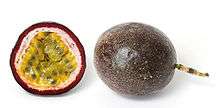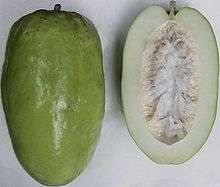Passion fruit (fruit)

The passion fruit is the fruit of a number of plants in the Passiflora family.[1][2][3] Edible passion fruits can be divided into three main types: purple ones (fruits of Passiflora edulis Sims), yellow ones (Passiflora edulis f. flavicarpa Deg.), and giant granadilla (Passiflora quadrangularis L.).[4]
Appearance and structure
Passion fruits are round or oval. They can be yellow, red, purple,[5] and green.[6] The fruits have a juicy pulp with a large number of seeds.[5]
Nutritional value
The benefits of the fruit are passionately argued for. The fruit is a source of carbohydrates, carotene, vitamin C, iron.[1]
The part of the fruit that is used (eaten) is the pulp. Passion fruits can also be squeezed to make juice.[7]
A whole fruit contains 68 calories per 100 grams. The amount of juice in passion fruits is 25–40%.[5]
Cultivation
Passion fruits are cultivated on an industrial scale.[2][8]
Gallery
 Purple passion fruit (Passiflora edulis)
Purple passion fruit (Passiflora edulis) Yellow passion fruit (Passiflora edulis f. flavicarpa)
Yellow passion fruit (Passiflora edulis f. flavicarpa) Red, yellow, and green Passiflora edulis
Red, yellow, and green Passiflora edulis Giant granadilla (Passiflora quadrangularis L.)
Giant granadilla (Passiflora quadrangularis L.)
References
- 1 2 Конышев В. (12 January 2017). Еда без вреда: Азбука питания. Эксмо. p. 123. ISBN 978-5-457-03689-5.
- 1 2 Власова Н. (12 January 2017). Плодовый сад на вашем подоконнике. ЛитРес. p. 29. ISBN 978-5-457-41613-0.
- ↑ Dennis S. Hill (16 July 2008). Pests of Crops in Warmer Climates and Their Control. Springer Science & Business Media. pp. 605–. ISBN 978-1-4020-6738-9.
- ↑ Experts from Dole Food Company; Experts from The Mayo Clinic; Experts from UCLA Center for H (13 January 2002). Encyclopedia of Foods: A Guide to Healthy Nutrition. Elsevier. pp. 195–. ISBN 978-0-08-053087-1.
- 1 2 3 Ингерлейб М., Самойленко М. (12 January 2017). Целебные соки. Эксмо. p. 155. ISBN 978-5-457-42344-2.
- ↑ "Маракуйя". Официальный сайт кулинарных рецептов Юлии Высоцкой. Едимдома.ру. Retrieved 2017-02-24.
- ↑ Флоранд Л. (13 February 2017). Француженки не заедают слезы шоколадом. Э. p. 395. ISBN 978-5-04-039827-0.
- ↑ Волкова Е. (12 January 2017). Цветочные диковины на вашем подоконнике. ЛитРес. p. 22. ISBN 978-5-457-41725-0.
- Jane Grigson (1 April 2007). Jane Grigson's Fruit Book. U of Nebraska Press. pp. 291–. ISBN 0-8032-5993-X.